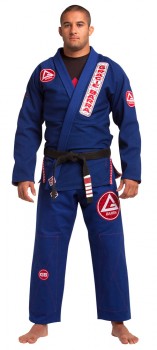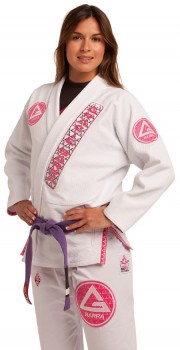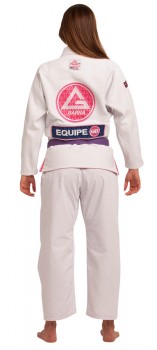5 Tips On How To Care For Your BJJ Kimono
If the samurai wore armour on the battlefield, then the student of brazilian jiu-jitsu wears their kimono when they step on the mat. Most kimonos for bjj are priced at $100 USA (and more!) and the student needs to know how best to care for their gi in order to protect the investment.
Here are some guidelines that have served me well in maintaining my kimonos over my training career.
 1) Buy a good quality kimono.
1) Buy a good quality kimono.
Certain brands have developed a well-deserved reputation in the bjj world as making durable, good quality gis with a great cut.
I personally prefer heavier weight kimonos compared to the lighter ones. Several students have been dismayed to discover that the so-called “Rip Stop” pants were anything but!
Once you have decided that you want to train bjj, you will consider spending a little more money for a quality bjj kimono that tends to be cut slimmer than the more baggy judo type.
GB store kimonos
I suggest buying multiple kimonos if your budget allows, since if you are training multiple times per week, you will not have enough time to wash and dry a single kimono in between classes.
A good kimono should last you through many years of use. I had one heavy weave that lasted 10 years before the sleeves finally frayed beyond use.
* Always select the larger size if unsure when selecting a gi. You can shrink it with a combination of hot water wash and dryer.
2) Immediately air dry your kimono after training.
 If you have ever made the mistake of forgetting your wet kimono in your training bag after class and left it overnight,..you will recognize the importance of drying it immediately after training.
If you have ever made the mistake of forgetting your wet kimono in your training bag after class and left it overnight,..you will recognize the importance of drying it immediately after training.
The dark, moist environment of the gi sitting in your training bag promotes bacterial growth. If enough bacteria establishes itself, it can create a permanent “off” smell in your gi.
One of my favorite kimonos suffered this fate. Even after freshly washing it, after a few minutes on the mat, an odor of “nacho cheese” would start to emanate from the kimono 🙁
(see tip # 4 for how to rid your kimono of nasty funk)
I find if I wear a rashguard under my kimono, then it absorbs much of the sweat and I can get more than a single class out of a washed kimono (as opposed to washing after every single use).
3) Washing
Since the kimono must be washed so often, this is a significant factor in caring for your kimono.
I don’t know any students of bjj who regularly use a clothes dryer to dry their kimonos (which promotes unwanted shrinkage). I wash in cold or warm water (after the initial shrinkage) and air dry (outside is best).
Bleach is widely considered a bad idea as it weakens the fibres of the kimono. The fibres are then more susceptible to tearing and it shortens the life of the gi.
Washing inside out is a good idea to preserve any patches.
Hot water will likely shrink your kimono and should be avoided.
For a NEW kimono: I have usually purchased kimonos that were sized slightly large for me and then used a hot water wash and a single dryer session to shrink it. After that one time I’d always air dry.
* be careful when washing a white kimono if there are any other coloured items in the washing machine. Most of us know someone who showed up at the academy with a pink kimono after the dye from a red item of clothing leeched into the wash water.
4) Funky smell?
 Ok, you forgot your $220 kimono in your gym bag in the car and now it smells like a wet dog – even after washing!
Ok, you forgot your $220 kimono in your gym bag in the car and now it smells like a wet dog – even after washing!
What do you do?
Bjj blackbelt and kimono manufacturer John Ouano gave me the advice to soak the stinky kimono is a water + vinegar solution overnight.
I filled a pail with water, poured 1/2 a small bottle of white vinegar in the water and left the kimono soaking overnight. Then I washed normally in the washing machine.
It worked and my favorite kimono was restored to lemony fresh scent!
* The theory is that the vinegar is a strong acid that destroys the foul smelling bacteria colonies
5) Loaning your kimonos
This is more of a practical piece of advice. When you bring a new friend along with you to try a bjj class, you will likely loan them one of your kimonos for the class.
At the end of the class, your friend will likely offer to wash the kimono at their home and return to you clean at a later point.
I would suggest you take the sweaty kimono home with you and wash it yourself – for two reasons:
 – if your friend’s enthusiasm doesn’t result in them returning to class you can have a difficult time meeting them to retrieve your kimono. I know several training partners who have lost kimonos due to acquaintances not returning them after borrowing.
– if your friend’s enthusiasm doesn’t result in them returning to class you can have a difficult time meeting them to retrieve your kimono. I know several training partners who have lost kimonos due to acquaintances not returning them after borrowing.
– your friend will wash the kimono and, not knowing, toss it in the dryer and shrink your $200 kimono to dwarf proportions! It happened to me and I lost a $160 favorite gi, so please learn from my loss.
Credits: Mark Mullen
Gracie Barra Black belt based in Taipei, Taiwan
Twitter: @MarkMullenB

